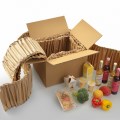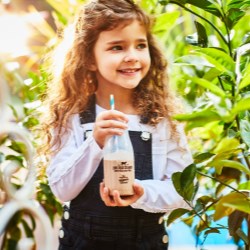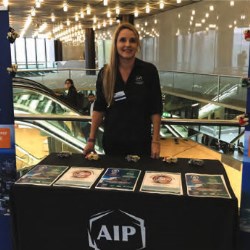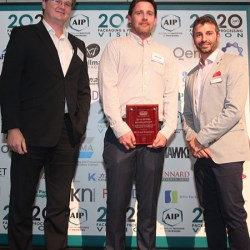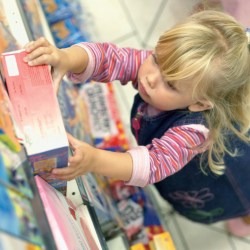If this is your company, CONTACT US to activate Packbase™ software to build your portal.


You can take the paper out of rubbish, but you can't take the rubbish out of paper, otherwise Nestlé Oceania would not be importing packaging materials made of virgin board from Chile.
That was the message delivered by Paul Haberland FAIP Packaging Specialist Nestlé Oceania at the August meeting of Australian Institute of Packaging (AIP) in Melbourne. This was a joint meeting with Australian Pulp and Paper Industry Technical Association (APPITA) and based on the turn out we should tender for seating at the next Olympic Games. Not only did we have all seats filled but we received two Gold Medal performances from Paul, and Jim Selway Senior Technical Support Manager at Amcor.
Interestingly on the day that the first advice of this meeting was promulgated a message came through in an online newsletter to reinforce the concern about migration of unwanted substances into packaging materials. Packaging is a growing source of porcine contamination for Halal foods as result of animal fat-based lubricants used in production of some paper-based materials leaching into products, a laboratory test company has said.
Mr Haberland came to discuss how to ensure the safety of food packaging and commenced by telling us that 40 years ago focus was on technical aspects to reduce costs, intervening was the push to consider environmental concerns, and now safety compliance underpins all that is done in research and development.
Nestlé has commenced a global program of safety and compliance which appears to be a comprehensive approach to ensure that Nestlé's packaging in contact with food is safe for the consumer, based on today's knowledge and legislation. Brand owners generally are now realising that this issue was not being managed well by the packaging convertors and now take the management process of this into their own hands.
At the get-go Paul encouraged converters and manufacturers of packaging to work with the brand owners to ensure safety and compliance that will be beneficial to both. And most importantly to the public that consume vast quantities of packaged food. Even most food prepared at home comes into the kitchen packaged.
It was 2005 when the Italian health authorities indicated to Nestlé that Tetra Packs containing baby food and other products were not meeting the EU legislation on migration. Nestlé was not convinced that this was so as the supplier was conducting migration tests with satisfactory results.
The Italian health authority did not accept the assurance and the matter went to the court leading to the magistrate instructing the police to remove Nestlé products from supermarkets. The Italian health authority was quick to indicate that testing was based on an incorrect simulant being used which was water instead of the correct simulant which should have been Olive Oil. Nestlé products in Tetra Packs were withdrawn from sale in Italy, Spain and France. The cost of this mistake was huge.
Incidentally, the compound which was migrating into the product was isopropyl thioxanthone(ITX) which is an ingredient of ink. It was Nestlé's name that was prominent in the paper and Tetra had a minor mention and the ink supplier no mention. So if this did not flag caution to Brand Owners and packaging suppliers for vigilance as far as food safety is concerned what would?
Was ITX the only issue? Research in Italy and Germany showed that Diisopropylnaphthalenes(DIPN) from recycled paper used in board for food packaging may migrate into food. This survey confirmed that DIPN can be found in packaging made from recycled paper and board and in some of the food samples contained in such food packaging.
These sorts of findings make great headlines and can not only cause food packers to lose confidence that their packaging is safe, but consumers will shy away and be hard to convince that tabloid journalists often manipulate the story away from the truth.
Nestlé Australia made a decision to convert all the breakfast cereals cartons from a recycled board to a virgin board. This was triggered by the concerns of contaminates in the recycled board and specifically of polycyclic aromatic hydrocarbons (PAH) in ink with the possibility of these migrating to the product.
Subsequently the company changed to a virgin board which means that millions of dollars worth of board is not being purchased from Australian manufacturers and virgin board is purchased from Chile.
So Nestlé then determined that it should take arising concerns more seriously and apply a higher level of management to ensure that packaging was really safe. It determined that three main issues were the root cause:
- Lack of knowledge
- Insufficient partnership with suppliers
- Lack of monitoring
What is now known as Pack Safety Network entails supplier audits, certification of compliance and monitoring.
Certificates of Compliance are documents which Nestlé must have for each material specification. They contain statements that the material complies with the legal requirements of the country that the material will be sold in, together with migration data and a list of all the starting components which have gone into the manufacture of that material.
Monitoring is the process of determining a testing program to be conducted by Nestlé to address some of the possible risks associated with the use of material offered for supply. Supplier audits are the first section of the process which impacts the supplier. This audit evaluates the risk of contaminate getting into the final packaging when manufactured.
But there are always roadblocks; for instance a supplier may be willing to undertake all the evaluation required by a Brand Owner but not be able to ascertain from its supplier exactly what is in the product that they obtain to make the final package. Nestlé would be more than willing to enter into confidentiality agreements with downstream suppliers to satisfy pack safety network requirements.
There were many aspects of regulations covered but these are readily available not like the wealth of knowledge expounded by Paul Haberland who left us with this message:-
"It is Nestlé's objective is to become skilled in the understanding of the EU requirements on packaging safety and be compliant with Nestlé's packaging locally. Nestlé's program goes further than having our supplier indicate that we are meeting the EU requirements because generally this cannot be substantiated without specific testing. But the Safety and Compliance Program gives Nestlé the ability to confirm that we are achieving compliance and allows me to sleep well at night."
Jim Selway and Dush Kannangara had put together a program to show the technical and intricacies of simulation testing for transport within Australia. Jim could appear on Saturday Night Live or some similar show and be as appreciated by its audience for his humour as he was by us for his professional overview of an important but least considered component of the supply chain.
To construct a box to survive the rigours of transport, particularly in Australia and the tyranny of distance, manufactures measure Compression Strength which will determine initially if the basic tenant of packaging "to protect the product from the environment and the environment from the product" can be met.
At Amcor testing facility they use sophisticated machinery and computer software to calculate the load supported by boxes on the bottom layer of a pallet. The program allows technicians to calculate the safety factor of the unit being tested and make comparisons against what is considered to be the minimum safety factor.
Experience shows that every packaged product undergoes shock and Vibration inputs which are generally unique to the specific product and its package. Transport simulation provides a uniform basis to evaluate the ability of shipping units to withstand vibrations in a distribution environment.
The benefits of Vibration testing are:
- Identify design and Production defects
- Increase Product Ruggedness
- Reduce Packaging costs
- Eliminate Shipping Damage
Even with a solid track record some trends such as retail-ready packs have reset the bar for transport companies and no doubt the retailer's warehousing protocols but also at testing facilities. Simulation of regular slotted containers would have been well documented and easy to manipulate for specific movement away from the norm. But because someone decided to score the side wall of the shipper to satisfy the ease of opening requirements at the retailers all considerations and history need to be revaluated.
Compression is through the corners and sidewalls of the shipper and interfering with the sidewall will shift the pendulum very much into the negative range. The development of small unit packs made of paperboard rather than corrugated has compounded the damage risk and in many cases reduced the efficiency of palletising. What used to be a retail unit is now required to be a safe transport package!
To quote Jim "Retail ready has made grown men cry". "The thinking behind some concepts is simply preposterous" and "many carton board people do not know about compression strength". With the need for more testing in the modified supply chain test laboratories at Amcor Technical Services and Victorian University is more and more being called upon to provide solutions to what some consider self-made problems. Testing revolves around standard ASTM D4169 and ISTA- the International Safe Transport Association.
In a totally competitive world it was interesting to hear Jim Selway place accolades upon the technical people at Victorian University where he says world's best practice for testing and simulation is being achieved.
Much of the presentation showed graphically the variations in shocks and vibration detected during both live and simulated tests, but problems abound, not the least being the reluctance of companies to provide enough units for testing or the time to evaluate. In the presentation and at question time instances of unexpected shock and vibrations attributed to truck drivers were put forward. It was not asked but one wonders if the simulation software takes into account strange happenings that occur in the Pilliga State Forest on the highway most taken by transports to and from Queensland. The "yeti" that exists there like SRP has made grown men cry. Only the truckle’s laundry person knows the exact result of the simulation that occurs out there.



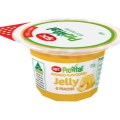
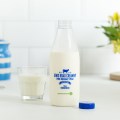
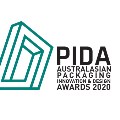
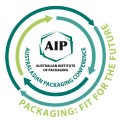
.jpg)







